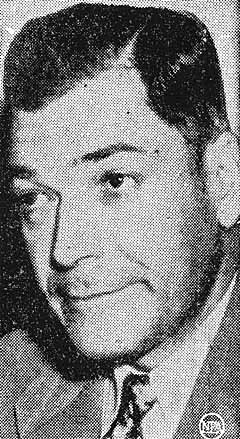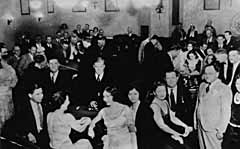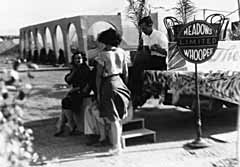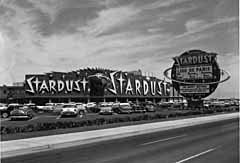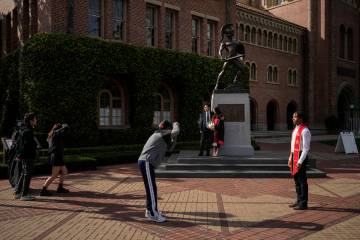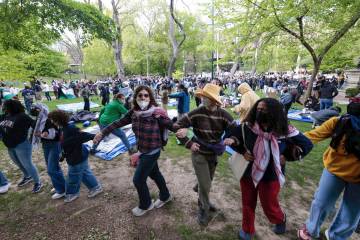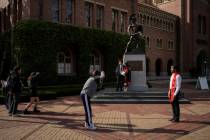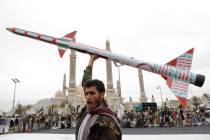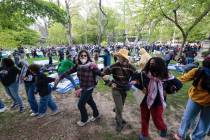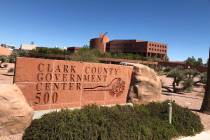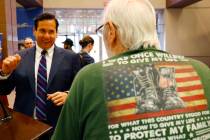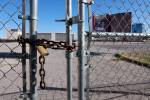Tony Cornero
Tony Cornero typified the entrepreneurs who built the Las Vegas Strip. More sinner than saint.
Consider the hotels lining Las Vegas Boulevard in the mid-1960s: Flamingo, Sands, Desert Inn, Sahara, Stardust, Riviera, Dunes, Tropicana, and then think of the men who built or managed them. Ben Siegel, Gus Greenbaum, Jake Friedman, Jack Entratter, Moe Dalitz, Milton Prell, Davie Berman, Milton Jaffe, and Tony Cornero, come to mind. Foreign-born or the sons of immigrants, these men who invested their skills and capital in a small Mojave Desert city had operated on the other side of the law for decades.
Providing liquor and gambling to Americans in the 1920s and 1930s was a somewhat dangerous enterprise, yet one that provided opportunities for wealth and power for those willing to take the risk.
Tony Cornero -- also known as Tony Stralla and Admiral Cornero -- got his start toward achieving the American dream during Prohibition. Rare indeed was a Las Vegas Strip founding father in the two decades after World War II who had not been involved in manufacturing or distributing liquor in the 1920s. Cornero's specialty was overseeing the unloading of banned libations from ships waiting off the Southern California Coast to smaller craft which would speed to deserted beaches before dawn. Unlike most bootleggers who invested their talents in Las Vegas, the "Admiral" got caught and was convicted.
Soon after his release Cornero and his brothers, Frank and Louis, were in Las Vegas to organize construction of a casino and small hotel a couple of miles away from the bars, restaurants and businesses along Fremont Street. Cornero was a convicted felon, so Frank and Louis stepped forward to apply for licenses. The brothers were making arrangements with local builders and lining up public support even before the Nevada Legislature, trying to build tourism and to help local governments find sources of revenue during the Depression, had relegalized gambling. It is not unreasonable to assume that Cornero may have done some lobbying in Carson City.
Cornero had a vision of a Las Vegas far different from the dusty railroad stop that it was. He saw a Las Vegas of classy, carpeted casinos, quite distinct from the tiny places, with sawdust on the floor, which opened after the gambling bill was signed into law by Nevada governor Fred Balzar. Classy casinos would attract wealthy men and women. Cornero even built a landing strip for the small planes that he hoped would bring those who had weathered the Depression.
Cornero's creation, the Meadows, was built near the intersection of Fremont Street and Charleston Boulevard, and it was impressive in its time. Photographs show guests, many from Las Vegas' professional and business elite, dressed in Sunday best rather than the jeans and boots, which were more common at the time. Local business and civic leaders expressed appreciation for the new business in a 10-page supplement of the May 3 Las Vegas Age. "Potent in its charm, mysterious in its fascination, the Meadows, America's most luxurious casino, will open its doors tonight and formally embark upon a career which all liberal-minded persons in the West will watch closely," wrote the Age.
The hotel had only 30 rooms, but the local newspaper pointed out they were "all with bath," and that hot water was available at all hours. It even pointed out that the Meadows had electric lights. Jack Laughlin, producer of such well-known stage shows as "No, No, Nanette," was hired to create the "Meadows Revue."
The Meadows was popular with Las Vegas society, partly because the Corneros, being rumrunners, served imported liquor of a consistently high quality. Their competitors often had to make do with whiskey manufactured in Lincoln County or the bathtubs of North Las Vegas.
But the Depression was not a good time to operate a hotel and casino. Two months after the Meadows opened, the Cornero brothers sold the hotel to Alex Richmond, a Southern California hotel owner and builder. The hotel rooms were put out of commission by fire on Labor Day 1931. The Corneros retained the casino until early 1932.
The Las Vegas Evening Review-Journal In February 1948 -- long after the fact but while the newspaper was still controlled by political insider Al Cahlan -- asserted that before opening the Meadows, the Corneros "maneuvered politically for adoption of a city anti-prostitution ordinance," which would have closed the brothels of downtown's Block 16 and forced prostitution into the county, where the Meadows would capture the business.
The prostitution ban did not pass, and "there were several citizens who had promised the Corneros certain things and then couldn't complete their promises, who departed the city by the light of the moon." This theory would explain why they sold the hotel rooms so quickly after opening.
Neither discouraged nor depleted of capital, Admiral Cornero returned to the Pacific, determined to realize his vision for Las Vegas when circumstances would be more propitious.
Cornero floated the Rex, a gambling ship that sat outside the three-mile limit but could be reached in 10 minutes by water taxis cruising from the Santa Monica Pier. Gambling was not then a federal crime, and Cornero was confident he could rake in large profits.
He was wrong. A variety of local and state officials expressed outrage. Even the Las Vegas press was angry, ostensibly because Cornero was breaking the law. Soon law enforcement officials tried to stop high-seas gambling on the Rex, with often comic results.
Boatloads of officials tried to board, but Cornero's crew bluffed them away, sometimes by aiming fire hoses. Cornero's brother, Frank, was even charged with kidnapping an investigator from the district attorney's office, though the charge was later dismissed by a judge who ruled there was insufficient evidence the investigator had been forced to board the Rex.
Eventually Los Angeles County deputies were able to board the Rex. The sheriff brought photographers to capture the deputies axing roulette wheels and hurling craps tables overboard.
Cornero's legal problems were far from over. California officials decided that the Santa Monica coast was a bay and Admiral Cornero was violating the three-mile limit because he was not three miles beyond an imaginary line drawn from the north side to the south side of the bay.
Cornero developed expertise in maritime law as he first lost his case in District Court, had the verdict overturned on appeal, and finally lost it again in the California Supreme Court. During the litigation, Southern Californians continued to take the 25-cent water taxi rides to the Rex. And Admiral Cornero continued to reap profits of more than $200,000 a month.
Cornero's exploits were front-page news in Las Vegas. Editorials warned that Cornero, the California folk hero who had repulsed legal authorities, was not welcome in Las Vegas. Since the Rex's gambling area was larger than any three Las Vegas casinos and many experienced dealers had gone to work for Cornero, jealousy probably contributed to the criticism.
By 1939 the struggle between Cornero and the protectors of public morality had reached a climax. California Attorney General Earl Warren is now remembered for his efforts as Chief Justice of the U.S. Supreme Court justice to protect citizens' rights against government intrusion. But in those earlier days he launched a full-scale attack on both the Rex and the water taxis with ships borrowed from the state's Fish and Game Commission.
After the Californian ships had surrounded the Rex, Warren announced, "We're prepared to besiege them until they give up." Cornero replied that he would go down with his ship. Nine days later Cornero surrendered, claiming he changed his mind because: "I have to get a haircut and the only thing I haven't got aboard ship is a barber."
Cornero might have been able to win his battle with Earl Warren, but the federal government decided that while the gambling was not illegal, gambling ships would hamper preparations for a possible conflict in the Pacific. When the Coast Guard seized the Rex in November 1939, Admiral Cornero, realizing that he could not win, announced that he would operate a legitimate shipping company. He did so through 1944, and, by his own accounts, also acted as a secret U.S. agent in South America.
In spite of the earlier failure of the Meadows, Cornero remained convinced that Las Vegas could be a gambling mecca. Southern California's population had grown substantially during the war and Cornero knew that the residents of the Los Angles Basin needed more than mountains and beaches for recreation. He contacted Pietro Orlando Silvagni, builder of the Apache Hotel, leased its casino and changed its name to S.S. Rex.
Once again the defenders of public morality protested. City commissioners publicly told Silvagni that his association with Tony Cornero was the reason for a 3-2 vote denying a gaming license.
Commissioner Al Coradetti explained, "I would like to see P.O. Silvagni clean house. It is our business to see that we know who is going to run this place for Silvagni. I don't want Bugsy Siegel and people of his stripe in here, and until I know who is going to run Silvagni's place, I'll vote against the license."
Two weeks later, on Dec. 22, 1944, Coradetti, apparently persuaded that Cornero would not actually control the casino, joined two other city commissioners in voting to give Silvagni his license. Cornero continued to be associated with the S.S. Rex for six months, until Silvagni, facing another licensing battle, severed his connections with him.
Cornero was not discouraged. Rather, he returned to Southern California and bought a new ship, the Lux, which he anchored off the Long Beach coast. Thousands of citizens took the short trip to the Lux while local and state officials fumed. The guardians of public morality then seized the water taxis, surrounded the Lux and exchanged insults with the Admiral and his crew. Eventually Cornero surrendered, went to trial and was found innocent, and immediately reopened the Lux.
Once again, though, the feds were the Admiral's nemesis. The Coast Guard seized the ship because it was not fulfilling the purpose of its license. Instead of engaging in coastal trade, it was anchored off shore, functioning as a floating casino. Cornero realized that his days as an admiral were over as congressional support grew for a bill to outlaw gambling in the U.S. coastal waters.
When Congress passed the bill in 1948, Cornero was already planning to invest his capital and gambling expertise in Mexico's Baja California.
Once again, he faced adversity. Answering the door at his Beverly Hills home, he was shot by an unidentified gunman. The bullet entered Cornero's stomach and tore out part of his intestine. He was in serious condition for several weeks. The victim was treated unsympathetically by the police. One law enforcement officer reported that "Cornero was evasive as a typical gangster." Another said, "Whenever I tried to pin him down, he acted like he was in pain."
His shooting and recovery received critical coverage in the Las Vegas press, with Cornero portrayed as a totally unsavory character. Clark County Sheriff Glen Jones said, "The police chief of Beverly Hills wants Tony out, but he and his brothers gave the local constabulary distinct pains when they operated here before and we have no intention of seeing him as an asset."
Cornero began sharing his dream of building the biggest, plushest hotel along the Strip. He settled on the name Stardust and shared his vision with potential investors, mostly Southern Californians but also some Las Vegans. Of course, Cornero did not worry about the finer points of federal or state law as he raised capital. Like so many Strip entrepreneurs in the 1950s, he kept records of investments in his head or on paper he often carried with him. Perhaps $10,000 would bring to the investor 5 percent of the profits of the showroom, or 2 percent of the profits of the hotel. Cornero was an effective salesman and had a good track record of producing returns.
Undaunted by the cool reception from Las Vegas officials, Cornero pushed forward with his grand plan to build a 1,000-room hotel on the Strip. By July 1955, he had spent more than $3 million and had personally overseen construction of about 70 percent of the Stardust.
Cornero's Beverly Hills brush with death did not change his outlook on life. He worked hard and played hard. Like so many of the men who built the Strip, Cornero loved to gamble. He spent many hours at the gaming tables of the nearby Desert Inn. On the morning of July 31, 1955, he made his last roll of the dice, clutched his chest, and collapsed. The next day Las Vegas newspapers carried front-page stories about his life and death. Review-Journal reporter Bob Holdorf best captured the circumstances of his death:
" Tony died the way he had lived.
"He died at a gambling table.
"Probably, the diminutive gambler was happy as hell when he felt the surging heat whip across his chest and blot out the world.
"What other way was there for him to go?
"In a bed? Never!
"In a gun battle? They tried that!
"In an ambush? They tried that, too!
"Tony went the way any tough gambling hombre wants to get it. Fast and painless! The pain that hit Tony Cornero Stralla lasted something less than 10 seconds and then it was all over.
"He had crapped out."
Desert Inn owner Moe Dalitz and his Cleveland associates oversaw the completion of a slightly less lavish Stardust than Cornero had envisioned.
--
Dr. Alan Balboni teaches American Immigration History and American government at Community College of Southern Nevada. His book, "Beyond the Mafia: Italian Americans and the Development of Las Vegas," was published by the University of Nevada Press in 1996.
Part I: The Early Years
Part II: Resort Rising
Part III: A City In Full



